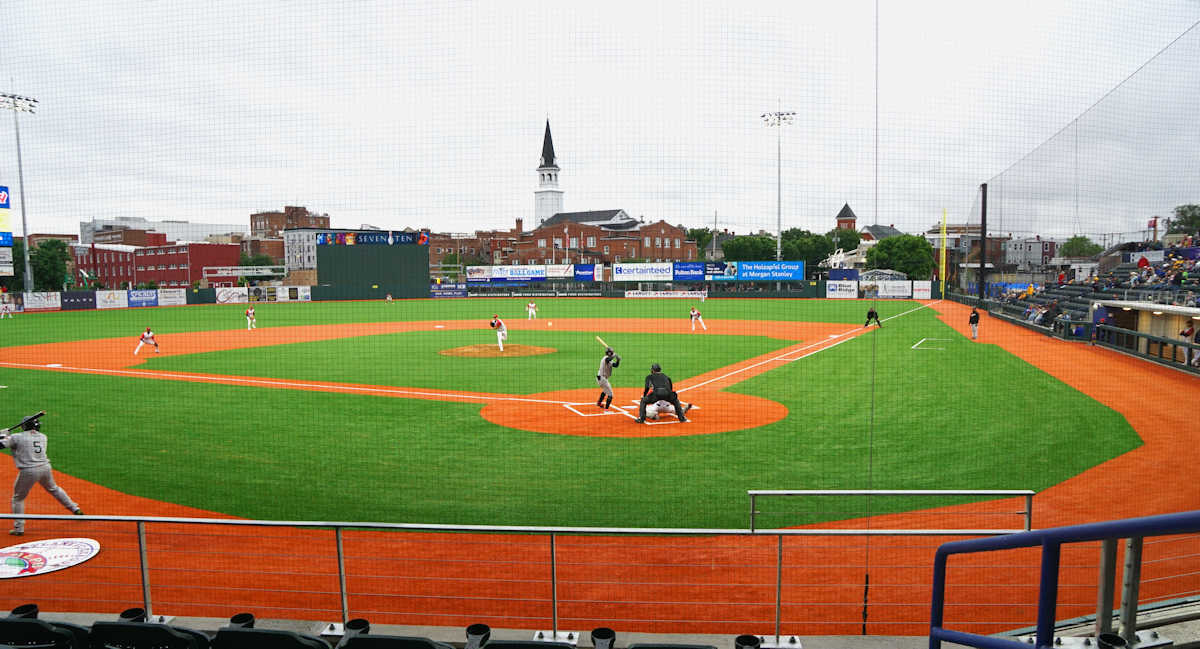
Article and photos (except as otherwise noted) by Joe Mock, BaseballParks.com
All rights reserved
HAGERSTOWN, Maryland In the middle of the 20th Century, the biggest employer in Washington County, Maryland was Fairchild. At one point, there were 10,000 workers at their Hagerstown operations, meaning one in every three individuals living in the area was an employee there.
| Ballpark Stats |
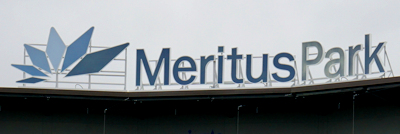 |
| Team: Hagerstown Flying Boxcars of the Atlantic League |
| First game: May 4, 2024, a 6-5 win over the Long Island Ducks |
| Capacity: 5,500 for baseball (8,500 for a concert), including 3,800 fixed seats |
| Dimensions: LF – 346′; LCF – 387′; CF – 400′; RCF – 360′; RF – 325′ |
| Fence heights: LF – 8′; CF – 36′; RF – 16′ |
| Architect: Pendulum, Jonathan Cole principal |
| Construction: Turner |
| Price: $89 million, funded by the State of Maryland |
| Home dugout: 1B side |
| Field points: North by northeast |
| Playing surface: AstroTurf. All surface is artificial, except the clay pitching mound |
| Corporate sponsor: Meritus Health |
| Ticket info: flyingboxcars.com/tickets/ |
| Betcha didn’t know: When excavation started, a long-forgotten brick drainage tunnel was found under the site |
That plant was crucial to America’s war effort in World War II. “Following Pearl Harbor, the military needed thousands of training planes where pilots could learn to fly before being assigned to the larger fighter and cargo planes,” explains John Seburn, Executive Director of the Hagerstown Aviation Museum. The main hangar where numerous planes are today displayed was used by Fairchild more than half a century ago.
The company produced over 5,000 of these training planes. In fact, the workers became so efficient at producing them that the phrase “The Hagerstown System” was coined to describe this process.
Prior to World War II, when the military needed to fly large cargo, they typically retrofitted passenger planes — hardly an efficient approach. In 1941, the chief engineer at Fairchild designed a brand-new type of aircraft specifically to transport cargo. This super-secret project produced the C-82, as the “C” stood for “cargo.” Its fuselage was the same size as a railroad boxcar. The Air Force’s name for this craft was “Packet,” but “everyone around here started referring to it as ‘the flying boxcar,'” adds Seburn.
Fairchild produced 220 of these C-82s. In 1949, an improved version started rolling off of the assembly line in Hagerstown. This was the C-119 model. This time, the Air Force officially dubbed this The Flying Boxcar.
“Fairchild produced 1,100 of these from 1949 through 1955, so they served heavily in the Korean War,” explains the Museum’s Curator, Kurtis Meyers. “And 95% of the parts for them were made here. They were designed, prototyped and tested right here. The Air Force continued using the C-119 into the 1970s.”
You’ve no doubt seen these cargo planes in the movies, as the back end swung open, providing an opening large enough for a full-size jeep to be driven into and out of the plane’s fuselage. The fame of the C-82 and C-119 led to Hagerstown becoming known as “The Home of the Flying Boxcar.”
Too large to fit easily in the Museum’s main hangar, an original C-82 sits on the tarmac behind the structure, ready for visitors to examine — and climb inside. This C-82 was the last one capable of flying, and was being used by a company in Wyoming to help extinguish forest fires. The Museum conducted a fund-raising campaign in 2006 to purchase this plane and fly it to Hagerstown from Wyoming, making it the final C-82 to take to the air. The campaign raised $140,000 to accomplish this.
This exact C-82 on display on the tarmac (photo below) served a very special purpose in July 2023, when it came time for Hagerstown’s new Atlantic League franchise to announce the winner of its Name The Team Contest.

The event was held at the Hagerstown Aviation Museum. Why? Because the nickname announced was the Flying Boxcars. This C-82 was wheeled to the hangar, with its back opened and a podium for speakers to announce the new team’s nickname. “It was an event,” the team’s GM David Blenckstone observed wryly.
I didn’t feel the need to do an exhaustive legal search on the matter, but I imagine the team had a clear path to trademarking that nickname for a baseball team!
So when I arrived in Hagerstown to cover the opening of the team’s ballpark, I started my day at that very museum. I was given a wonderful tour by Meyers (shown above in front of the C-82, on the left), Seburn (wearing the cap) and Karen Hemenway (in the center above), the Museum’s Donor Engagement & Event Coordinator. And those accommodating folks let me climb inside the fuselage of the Flying Boxcar itself. That was a blast.
If you are ever anywhere near Hagerstown, find out if the Museum is open (as of this writing, it’s open on Fridays and Saturdays) and visit it. It’s amazing. Check it out here: Hagerstown Aviation Museum
And just for the record, here is the C-119 that’s on display at the museum. It was the model the Air Force officially called The Flying Boxcar. The baseball team’s logo relies heavily on this look.
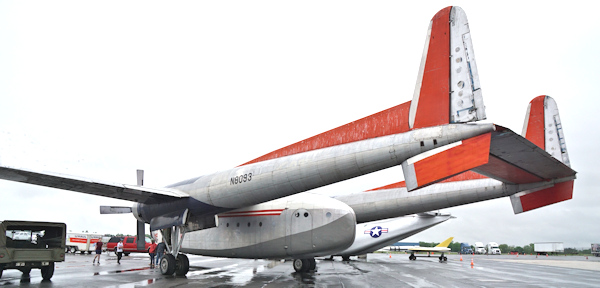
Just as the city has a long, proud history in the aviation industry, so too is its baseball past. The city’s first team is believed to be the Blues, who first took the field in 1915. Fifteen years later, Municipal Stadium opened. It was the home for organized baseball in Hagerstown for the next nine decades, starting with the Hubs in 1930, the Owls in 1939, the Braves (some years known as the Packets) off and on through 1955, and following a 25-year absence, the Suns in 1981.
The Suns had a variety of Major League affiliations during their four-decade run at Municipal Stadium, with locals recalling most fondly their years as an affiliate of the Baltimore Orioles from 1982 through 1992. This was followed by stints with the Blue Jays (1993-2000), Giants (2001-2004), Mets (2005-2006) and finally the Nationals (2007-2019).
All the while, the market desperately needed a ballpark to replace Municipal Stadium, which was well past its prime and didn’t come close to meeting Major League Baseball’s standards for Minor League parks. When COVID wiped out the entire Minor League season in 2020 and MLB contracted 40 affiliated franchises in 2021, Hagerstown found itself without a team.
Efforts to bring about a new facility started well before the loss of affiliated baseball, though.
Everyone associated with Hagerstown’s new team points to an individual who was immensely pivotal in this process: Paul Corderman.
| Municipal Stadium |
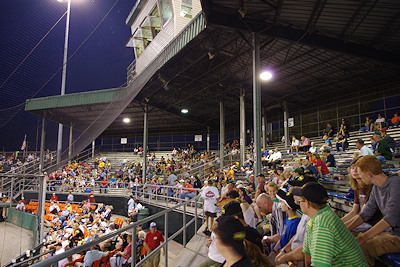 |
| This shows Hagerstown’s now-demolished Municipal Stadium during a Suns game in 2010. Even by that time, the facility was badly dated and truly needed to be replaced. Historical note: Willie Mays played his first game in “white” baseball here right after signing with the Giants in 1950. |
Today, he is the state senator representing District 2 in the Maryland General Assembly in Annapolis. Four decades ago, he was a boy growing up in Hagerstown, whose father would take him to Suns baseball games. “As was the case with many kids growing up in this community, we would stand out in the parking lot (of Municipal Stadium), hoping for a foul ball to come up over the top of the grandstand. I think in my mom’s attic there’s probably a box of baseballs that I gathered over the years from going to Suns games.
“There’s definitely a vivid image from my childhood of being there.”
Hagerstown’s need for a new ballpark “is one of the things that got me involved in local politics,” says Corderman. While there had been numerous conversations over the decades about building a new park in various spots around town, “what really got my attention would have been in 2012, when there was a concentrated effort to build a new ballpark downtown.”
However, he says the Suns’ out-of-town owner at the time wouldn’t commit to staying in Hagerstown, and flirted with moving the franchise to various markets in Northern Virginia. With each new overture about moving the team, the Suns’ ownership further alienated the local government and business community in Hagerstown. “I said, you know what? I’m going to run for city council and get involved with this. And I’ve been committed to this project ever since. To me, it was the ultimate long game.” He was elected in 2016.
He soon realized that it was going to require a very bold plan to obtain approval and funding to build a new downtown ballpark in his hometown. This was going to necessitate the involvement of the State of Maryland. Naturally, Corderman ran for state senate and won.
But he fully realized that “For the State of Maryland to come in and fully finance, plan, design and build had never been done before. That’s not how we’ve done Minor League stadiums in the past.” Again, he knew he was playing the “long game.” His first step was to win approval for a study to examine the feasibility of a new ballpark in Hagerstown. Then came a second, more in-depth study. These were necessary before the Maryland Stadium Authority — the entity originally formed in 1986 to pay for Oriole Park at Camden Yards — would consider any involvement in Hagerstown.
Then came the all-important bill proposed by Corderman to ask the General Assembly for $59.5 million for a new ballpark in downtown Hagerstown. “It was a real Hail Mary,” he recalls. “Everyone said the bill was out of left field, to use a baseball analogy. I gave it about a 5% chance of passing.”
Improving the chances was the involvement of local investors in acquiring a team. “In Minor League Baseball, you’ve got to have committed ownership. If you have someone that’s local, all the better. We had three of the finest individuals any community could ever ask for involved in this project — Blackie Bowen, Don Bowman and Jimmy Holzapfel. They aren’t in this to make money. They’re into this because it’s the right thing for our community.”
This ownership group is called Downtown Baseball LLC. There’s no mistaking where in Hagerstown they wanted the ballpark to be built!
Against all odds, Corderman’s bill passed. Not only that, another $8.5 million from the governor’s supplemental budget was added to the project, as was $1.5 million from the state’s capital budget.
Suddenly, the project had nearly $70 million to purchase properties, kickstart the design process and start requesting bids to acquire construction materials.
But they soon learned it wasn’t enough.
| State Senator Corderman |
 |
| Hagerstown native and State Senator Paul Corderman “was the linchpin to getting funding for this project,” says Flying Boxcars’ GM David Blenckstone. “I seriously doubt this project would have come to fruition without Paul’s support.” In the photo are catcher Tyler Hill, Hagerstown-Washington County Industrial Foundation president Greg Snook, Corderman and pitcher Chase Solesky. PHOTO CREDIT: Nick Betson |
The project faced the incredible hurdle of the supply chain disasters that were an outgrowth of the COVID pandemic. The bids coming back to supply the construction materials were roughly 30% higher than the same materials a year or two earlier. Corderman says, “We were looking at a $15 to 17-million gap.”
That presented two alternatives: chop out significant portions of the plan to keep within the $69 million budget; ask for more money. When the designers of the park reported what would need to be eliminated or scaled back, the changes gutted a lot of the features that would provide community amenities that the project was needed to provide — like event space and the ability to host non-baseball activities. So everyone agreed that more money was needed.
The problem with that, Corderman says, was that funds in a $200 million appropriation bill for the Maryland Stadium Authority to use on the state’s minor-league parks wouldn’t apply to Hagerstown, since the new ballpark wasn’t going to be owned by a local government. So Corderman pulled another rabbit out of a hat, and convinced lawmakers to (a) increase the $200 million for minor league facilities to $220 million and (b) make Hagerstown eligible to apply for it.
With a total of $89.5 million available, everything was back on track, and planning and construction could commence. All of this flurry of activity culminated in the end of State Senator Corderman’s “ultimate long game,” as the scene at the top of this page shows the very first pitch thrown at Meritus Park on May 4, 2024. In the rain. And the rain never stopped, but the AstroTurf playing surface held up perfectly and allowed an extra-innings contest to play to completion.
So let’s examine why the ballpark was located so close to downtown, and all of the challenges that the oddly-shaped site presented to the designers and builders … and why it cost almost $90 million to build, way more than other stadiums of similar size. We’ll then describe the facility’s exterior and interior design, and what the gameday experience is like. And we’ll wrap up our review with some educated guesses as to why it was designed to be far more equipped than other new indy league ballparks.
And a word of apology … the weather was miserable on opening day, and as a result my photos aren’t the best. I’m just thrilled, though, that the game was played as scheduled.
The Setting

There’s a sign you can’t miss within Meritus Park. It’s on a wall down the first-base line (above). It’s shown here with the lead architect of the facility, Jonathan Cole, principal at Pendulum.
Where precisely is Hagerstown, Maryland? It’s not exactly considered to be in Western Maryland, like, say, Cumberland. It’s on Interstate 70 about 25 miles west of Frederick, and about 65 miles east of Cumberland (you’d take I-70 and I-68 between the two cities). That means it’s about 75 miles west of Camden Yards in downtown Baltimore.
Hagerstown is in the skinny part of the state. In fact, the ballpark is only four miles south of the Mason-Dixon Line that separates Maryland and Pennsylvania, and four miles north of the Potomac River that runs between Maryland and West Virginia’s Eastern Panhandle.
By pro-baseball standards, Hagerstown isn’t a large city. The most recent census puts the population at 43,500, although the entirety of Washington County boasts a far more respectable 154,000 — certainly enough to support professional ball. Back when the market had affiliated Minor League Baseball, it never led its league in attendance, but that might be partially attributable to its sub-standard ballpark.
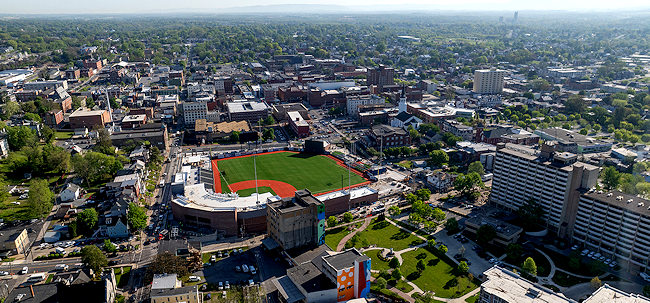
The new ballpark is on the southern edge of the city’s downtown. Since a picture is worth a thousand words, the drone shot above does the best job of showing you what’s around Meritus Park. This excellent photo is by Eric Hastings at the City of Hagerstown. We appreciate their permission to use it here.
This is looking roughly north, across the city’s downtown area. The street running parallel to the first base foul line is West Baltimore Street. You can’t tell it from the photo, but there is a fairly steep incline as the street heads toward the right-field foul pole. The multi-story building not far from first base is the Ellsworth Insulation Building. The much taller building a little farther to the east is a residential property — Potomac Towers.
The street running roughly parallel to the third base foul line is Summit Avenue. The block facing the exterior of the ballpark behind third base has a series of stately homes (photo below). In fact, the area under the location of the drone when the photo above was taken is very residential, meaning the ballpark itself is somewhat along the buffer between housing and commercial.

You might also notice that the perimeter of the park’s footprint is decidedly not a perfect rectangle. (“It’s way more of a trapezoid,” says architect Cole. More on the site’s challenges in a minute.)
While there is a gate to enter the park behind home plate, by no means is it considered to be the main gate. That is beyond center field, where the ticket windows are and the main merchandise store.
Most fans enter this center-field gate because that’s near the majority of parking (although don’t expect to find any available spaces adjacent to this gate) — plus it’s where downtown’s attractions are located.
| Upscale Bavarian |
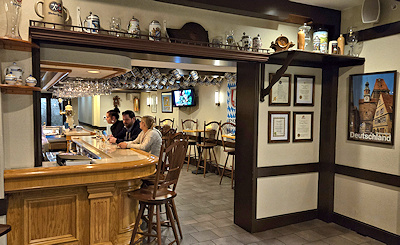 |
| Hagerstown’s history is heavily influenced by people of German descent. It only makes sense that an upscale German (actually Bavarian) restaurant graces the city’s downtown. I’ve dined at many fine German eateries, but none better than this one. You’ll find it at the corner of South Potomac Street and West Antietam Street, about three blocks from the ballpark. It’s a good idea to make a reservation. |
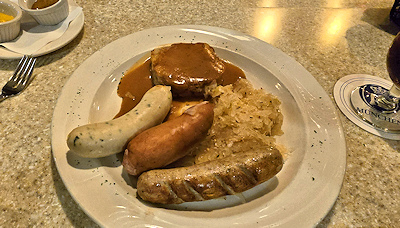 |
Corderman is clear that it wasn’t a love of baseball that caused him to work so tirelessly to make this downtown park a reality. “My love for this project wasn’t necessarily for baseball. Baseball just happens to be the anchor tenant that helps make the whole project work. Quite frankly, we want people to be on the streets. We want people to come to downtown Hagerstown.”
Within a few blocks of the park’s main gate are restaurants and the city’s gorgeous, historic Maryland Theatre, which dates back to 1915. See a show here. You’ll love it. There’s even a fully restored Wurlitzer theater organ there.
You’ll also find fine dining on the same block as the theater, like Bulls and Bears and the delightful Schmankerl Stube (see breakout box). There’s also the lovely St. Johns Lutheran Church, originally established in 1770. You can’t miss its towering steeple beyond right-center field when you’re sitting in the stands of the ballpark. This is a signature element of the view beyond the outfield.
Up and down these streets of downtown, you’ll find many shops and eateries to explore. That’s the hope the Maryland Stadium Authority anyway!
Meritus Park not only will “uplift our community, it will provide that investor confidence for all the exciting economic development opportunities around it,” says Corderman.
So the park is in the exact spot to accomplish these important things, but that doesn’t mean its site was easy to work with. Blenckstone notes that architect Cole “is an incredibly talented architect. He’s designed some great facilities, and this is one of them. But there are a lot of challenges with this location.” But he says that this didn’t prevent Cole from “stepping up to the plate and hitting a home run.”
Cole notes that the ballpark’s location and orientation lend themselves very well to future development. Had the main gate been behind home plate or if home plate had been in the northwest corner of the parcel of land, “it would have cut you off from future expansion.” But that didn’t make the site any easier to design a ballpark in the present.
“You’ve got to understand that this site is extremely tight,” he explains. “Even though it’s just over six acres, it has a very odd geometry. We also had to do archeological investigations because this site was an old rail station. The whole city goes back to the Civil War era, so there were concerns that there would be archeological items of significance.”
They also had to dig out and get rid of 21 tanks (For water? Heating fuel? Who knows?) found buried on the site, and account for an easement for stormwater in right field. “We also found a four-foot-wide brick drain line that existed all the way through. Plus there were also a lot of ups and downs (in the site’s elevation), so this was a complex design.
“When you look at this ballpark, the design contextually reacts to the site around it.”
One element that had to be dealt with before the ballpark could be constructed was the re-routing of Hagerstown’s Cultural Trail. This is a pedestrian and biking trail connecting the city’s Arts & Entertainment (A&E) District downtown with the Washington County Museum of Fine Arts in Hagerstown City Park. Unfortunately, this lovely path wove right through the ballpark’s site, so it was relocated along the right-field perimeter. The stretch of the trail from the downtown A&E district to the main gate of the ballpark is shown below.

This is the path many fans will use to walk to the ballpark after parking downtown. As you can see, it’s beautifully done.
Even with all of the challenges in the site and the park’s construction, Corderman’s “ultimate long game” came in right on time, as it was always envisioned to open for the beginning of the Atlantic League’s 2024 season.
Keep reading! Page 2 describes the exterior look of Meritus Park, its interior design and what it’s like to attend a Flying Boxcars game. Click below! And please make sure to leave a comment at the end of this review.